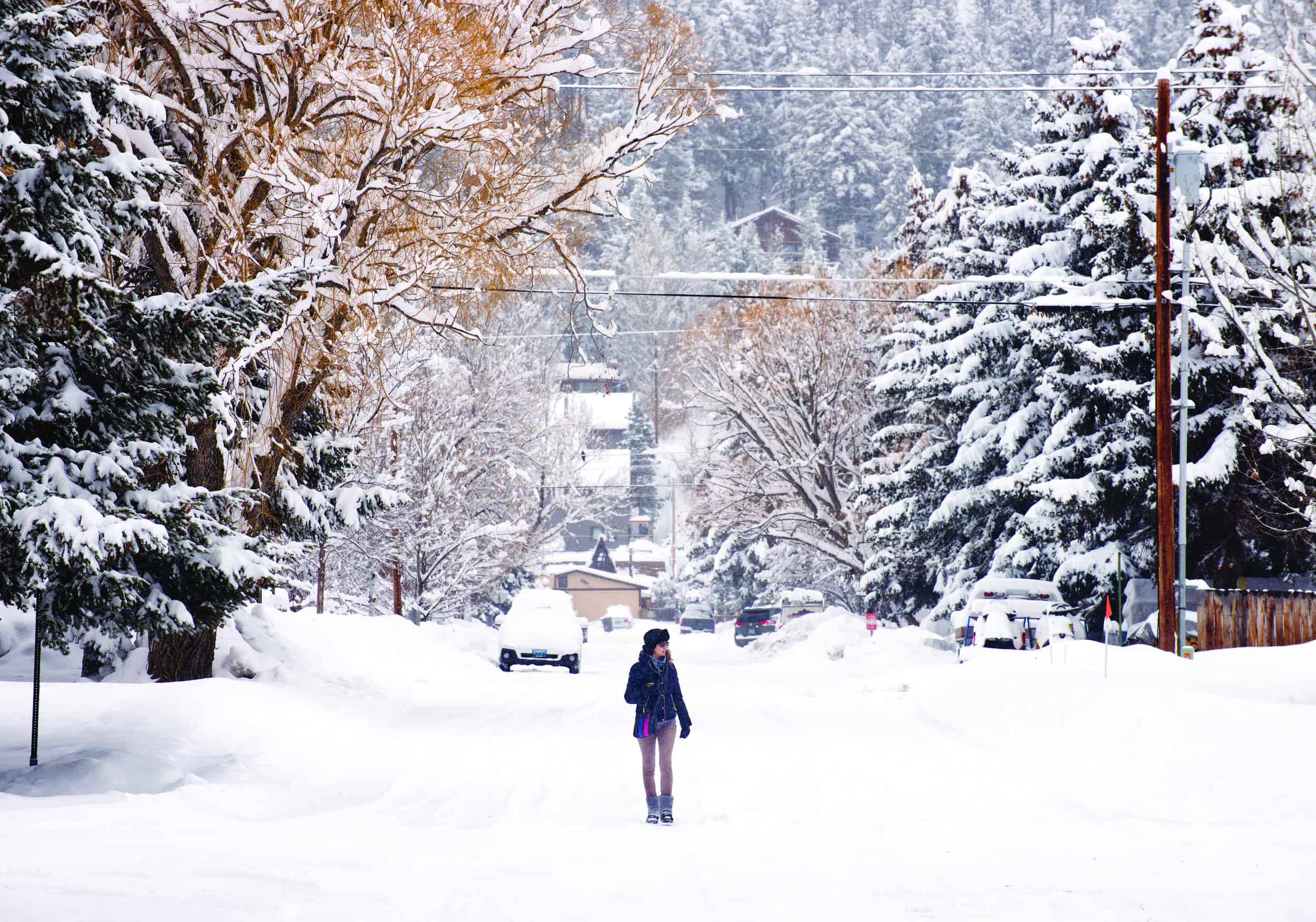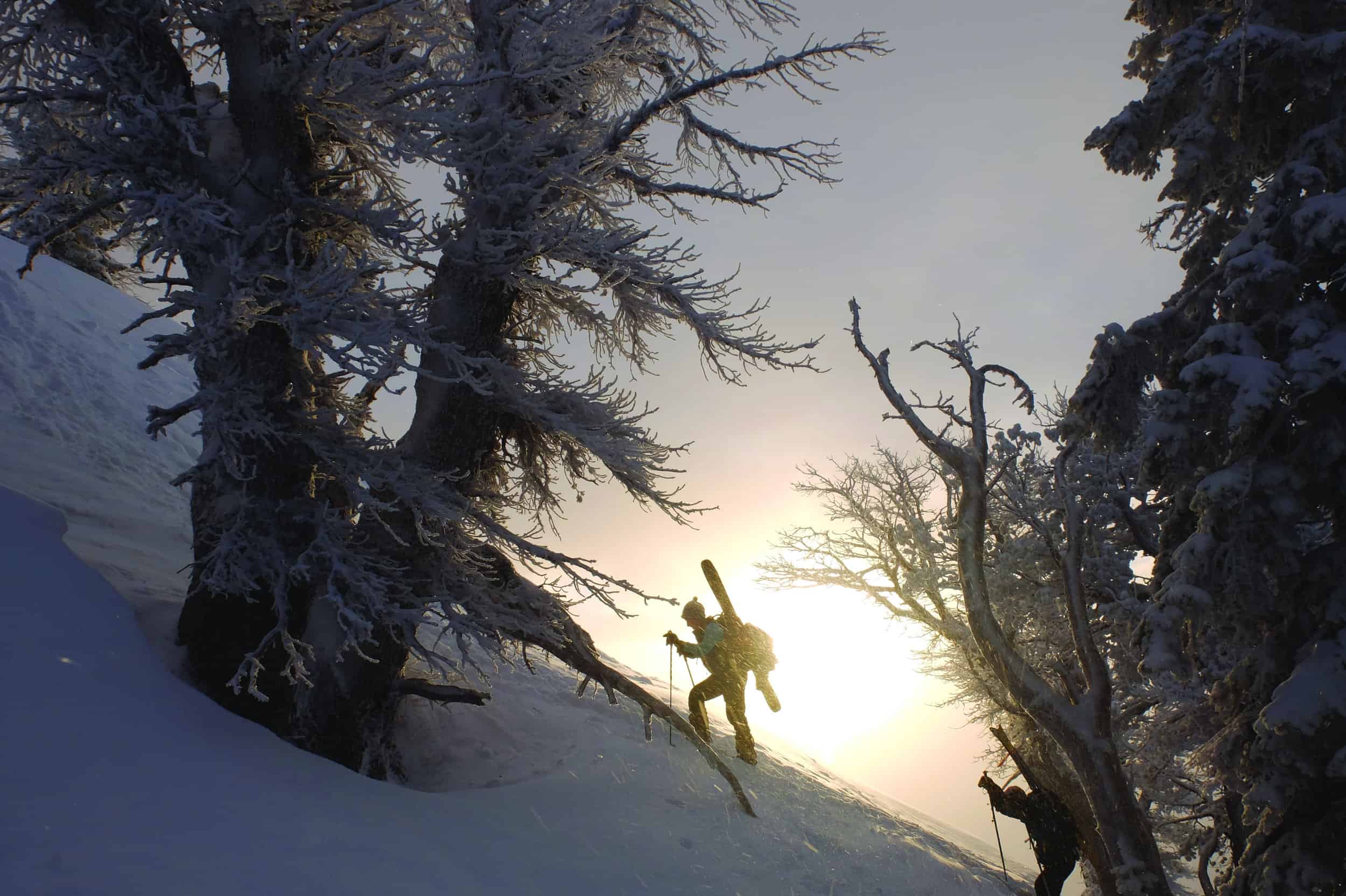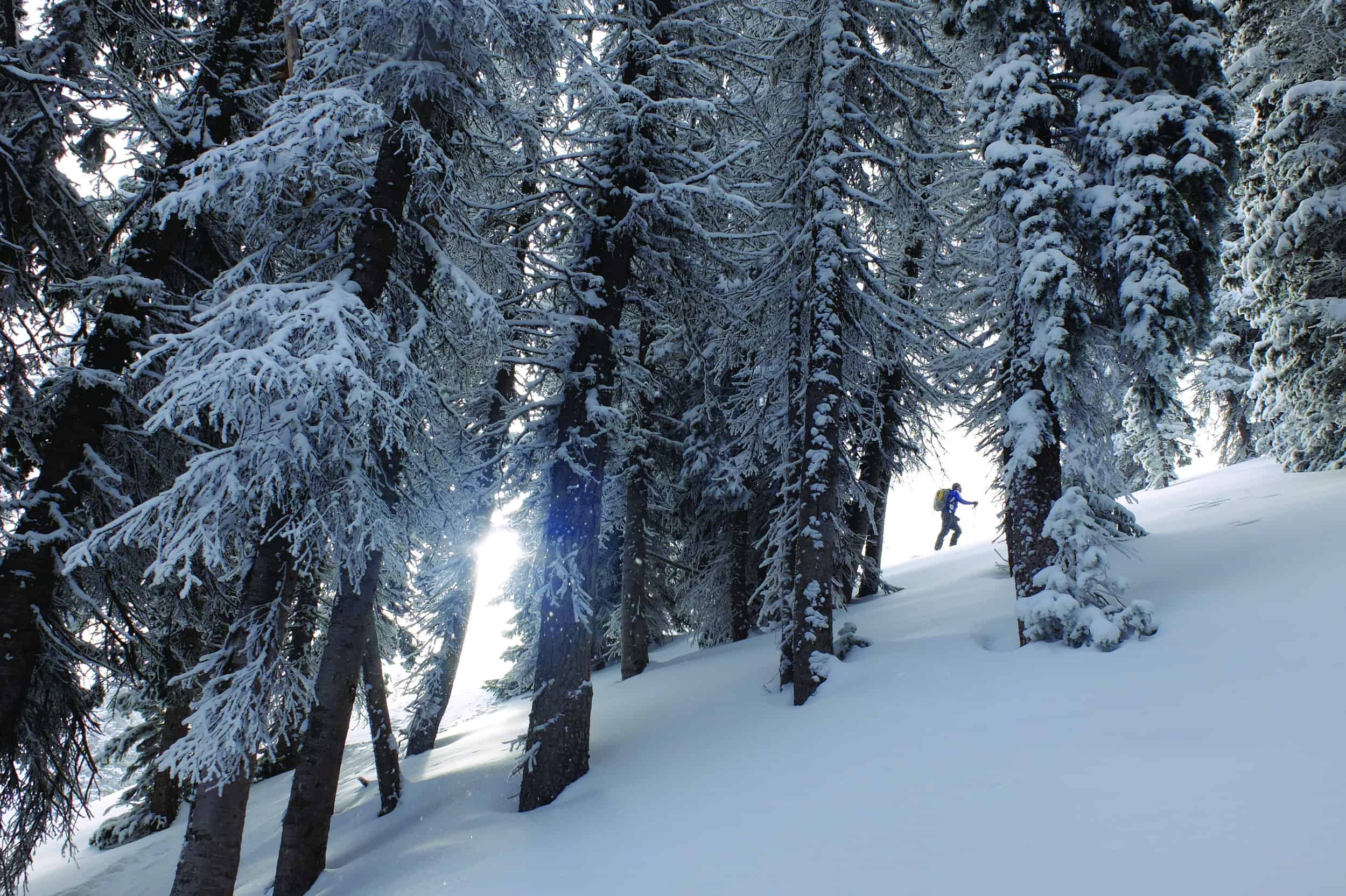Read The
Current Issue
Nature is the Cure
Spending time outside—no exercise required—is one of the easiest ways to improve your health and well-being.
// By Bevin Wallace // Photography by bradly j. boner

Every time I try to grab onto the rock face in front of me, my hand comes away, crumbling debris sifting through my fingers. My legs are shaking with the effort to find a decent foothold. I try not to look down because the sight of the valley far below gives me vertigo. There’s no going back down this couloir, which my friends and I had been told was “not as steep as it looks.” (I would argue it’s actually steeper.) While we’re not in mortal danger, I’m wearing shorts and know a fall would leave me banged up and bleeding. As I finally reach the grassy pass at the top of the climb, my slight panic gives way to euphoria—and one of the most spectacular, fairytale-worthy views I’d ever seen. I reflect on my recent life: after a bout of post-Covid inflammation that had kept me sidelined, I’m feeling healthy and strong for the first time in a long time. Yes, the last few minutes were scary, but they were also invigorating and life-affirming and definitely devoid of any feelings of sadness or malaise.
I was experiencing something we all probably suspect to be true—that spending time outside, especially in a beautiful place, is beneficial to our well-being. Turns out, beyond the sort of “well, duh” aspect of this concept, there is actual evidence that getting outdoors not only helps us mentally, it also improves our physical health. And getting outdoors does not have to involve scaling a steep couloir or even anything beyond a casual walk, or sit, in nature. Yes, apparently I could have gotten the same benefits without risking injury or blood. Several theories about why nature is good for us have emerged, but it’s a subject that is just barely starting to be understood well enough to be utilized for practical purposes. “The physiological response to being outside in nature is real, and it’s measurable,” says Michelle Kondo, a research social scientist with the USDA Forest Service’s Northern Research Station. “There are many physical and psychological benefits of nature that scientists have observed, which can better help us understand how nature supports wellness in the body, mind, and community.”
These studied and documented benefits—which include reduced stress and depression, improved sleep, increased vitamin D levels, better fitness, boosted immunity, reduced inflammation, and increased happiness and creativity—have led many doctors and therapists to recommend a daily dose of nature to their patients. “Getting outdoors is part of the prescription; there are undeniable benefits,” says Ryan Burke, a licensed professional counselor who has lived in Jackson Hole since 2004. “‘Nature-deficit disorder’ is becoming more accepted by therapists; the idea that we need to get outdoors in order to have a well-functioning mind and body is no longer a fringe concept. Our natural state is being outdoors, and we need to return to it and take command of our own individual lives.”
“We need to focus not just on what is lost when nature experience fades, but on what is gained through exposure to natural settings, including nearby nature in urban places.”
— Richard Louv, journalist and author of Child in the Woods: Saving Our Children From Nature-Deficit Disorder
Burke knows of what he speaks. A former binge drinker, he has found that outdoor activities—in his case, extreme triathlons in the Tetons that he comes up with himself to test his endurance—have helped him gain confidence and a sense of calm without using substances. Now he uses the personal strengths he discovered in himself to help his clients overcome what he calls the hazards of civilization: isolation, overstimulation, and being hyper self-focused. “Sometimes they might not really know what’s wrong, just that they feel bad,” he says. “If you can get outdoors and get that perspective of awe and feeling of calm, anxiety and depression tend to disappear.”
And even Burke agrees that “just walking or sitting outside helps.” According to a UK study published on nature.com, people who reported spending 120 minutes in nature per week (that’s just 17 minutes a day) had consistently higher levels of health and well-being than those who reported no exposure. The results also suggested that it didn’t matter how the exposure to the outdoors was achieved; some respondents preferred long walks on the weekends in locations farther from home while others made regular shorter visits to local parks, with the same results. If you’re fortunate to live in or visit a place as beautiful as Jackson Hole, with easy access to pristine wild areas, you probably already know about the boosts in mood you get from being outside and how just a look at the Tetons can zap your anxiety.
Want to be smarter and more creative? A study by cognitive neuroscientist David Strayer and his colleagues at the University of Utah showed increased performance on a creative problem-solving task by a full 50 percent in a group of hikers after four days of immersion in nature. “Our results demonstrate that there is a cognitive advantage to be realized if we spend time immersed in a natural setting,” the study’s authors wrote.
As for the physical benefits, I asked my doctor about this, and she agreed wholeheartedly (but off the record) that she believes spending time outdoors is crucial to maintaining good health. When every joint in my body flared up like a burled old tree this summer, she prescribed medication and told me to take it easy, preferably outside. I took that advice to heart and, instead of grueling hikes up high mountain trails, I went on casual walks through forests and parks—and spent hours just sitting under trees. The doctor-recommended “forest bathing” (see left) gave me a dose of vitamin D (regular exposure to sunlight is known to be the best way to get vitamin D, necessary for reducing inflammation and supporting the immune system) and potentially lowered my blood pressure—an effect of spending time in nature suggested by a recent University of Southampton study as well as a 2021 meta-analysis. It also has been shown that being outdoors improves sleep. A study by Stanford Medicine suggests that increasing the amount of time you spend outside helps to regulate body temperature and circadian rhythm. Oh, and something we all have a renewed interest in these days, immunity, seems to be improved by spending time in forests; plants produce phytoncides, which have been shown in studies to increase a type of white blood cell in humans, and sun exposure strengthens infection-fighting T cells.
In her 2017 book The Nature Fix, author Florence Williams writes, “We’re experiencing a mass generational amnesia enabled by urbanization and digital creep…. We don’t experience natural environments enough to realize how restored they can make us feel, nor are we aware that studies show they make us healthier, more creative, more empathetic, and more apt to engage with the world and with each other. Nature, it turns out, is good for civilization.” The book explores the optimal ways each of us can combat “indoor-itis” in our lives, and it ends with an explanation of the “nature pyramid,” a concept promoted by Tim Beatley of the University of Virginia. Based on the USDA’s food pyramid, it’s a recommendation for how much nature we humans need. Basically, it starts at the bottom with daily doses of nature near our home, including our pets and house plants. On the next level up would be weekly outings to parks and nearby places away from the bustle of the city, followed up a level by monthly trips to natural lakes and forests, and then at the top of the pyramid, a yearly multi-day trip somewhere in true wilderness, which scientists like Utah’s David Strayer believe are essential to optimal vitality.
“I don’t think everybody has to be a nature enthusiast,” says Mary Corelli LCPC, a therapist in Bozeman, Montana, whose practice includes earth-minded therapy that draws on nature to support mental health. “In fact, I respect that some people really prefer to be indoors or to live in big cities. But I do believe that nature, in no matter how small a dose, grounds us into healthy states of being. People may not want to go on long hikes, but if they can open a window and let a fresh breeze through, or stop to admire a tree in the neighborhood, they can sufficiently connect with the balance and goodness that nature provides.” Just start with those daily 17 minutes. JH
Get Out There
Your daily dose of nature can be simply sitting on your back stoop and gazing at the trees, but since the CDC recommends at least 150 minutes of moderate-intensity physical activity per week, why not do at least some of that outside? Exercising outdoors has benefits over hitting the gym: According to the American Council on Exercise, you’ll get a harder workout outdoors because you encounter a changing environment—bumps, obstacles, inclines, uneven surfaces—which requires your body to work harder, and burn more calories. You’ll breathe easier because outdoor air is generally cleaner than indoor air, according to the EPA, and of course you’ll get that free dose of vitamin D—not to mention the mental health benefits. According to a study published in Environmental Science and Technology, “Compared with exercising indoors, exercising in natural environments was associated with greater feelings of revitalization and positive engagement; decreases in tension, confusion, anger, and depression; and increased energy.”
But before you head out for a run, ride, or hike, make sure you’re doing it smartly, especially in wild natural areas like those surrounding Jackson Hole. Don’t be that cross-country skier who comes home frostbitten. That doesn’t benefit your health. Here’s a partial list of ways to stay safe and healthy when venturing beyond the backyard:
- Bring plenty of water—hot tea is great in winter—and food. Nothing spoils a healthy outing faster than bonking or dehydration.
- Wear sun-protective clothing, eyewear, and sunscreen. While getting vitamin D is important, skin cancer is still a concern, and the jury still leans toward using sunscreen at least most of the time you’re out in the sun.
- Have the proper equipment and apparel to dress in layers.
- Tell someone where you’re going, and preferably don’t go alone.
- Plan your route and bring a map (phones don’t always work in the backcountry).
- Check the weather forecast and plan accordingly.
No Actual Bathing Required
In 1982, to encourage people to put down their tech and reconnect with nature, the Japanese Ministry of Agriculture created the term shinrin-yoku, which translates to “taking in the forest atmosphere” or, charmingly, “forest bathing.” Since then, the concept of forest bathing has spread around the world due to its general pleasantness and touted benefits. Studies suggest being in a green environment reduces the production of cortisol—the stress hormone—and reducing stress can alleviate anxiety and depression, calm the mind, lower inflammation, and increase happiness. “Nature’s impact on our senses is very soothing,” says therapist Mary Corelli. “Hearing rushing water, seeing sunlight dance through leaves of a tree, feeling the cool air on our skin, or smelling the fragrance of pine needles can all lead us to a healthy state of sensory soothing and stimulation.”
While forest bathing can be as simple as sitting in nature, many books have been written about it (I recommend The Healing Magic of Forest Bathing by Julia Plevin) and it is a practice for which there are some basic guidelines: leave your devices at home, find a spot to sit or stroll (and no, it doesn’t have to be in a forest; just somewhere outdoors or even outdoors-adjacent and preferably kind of peaceful), try to use all five senses, and be mindful of what you see and feel. Be thankful and repeat daily if possible.







